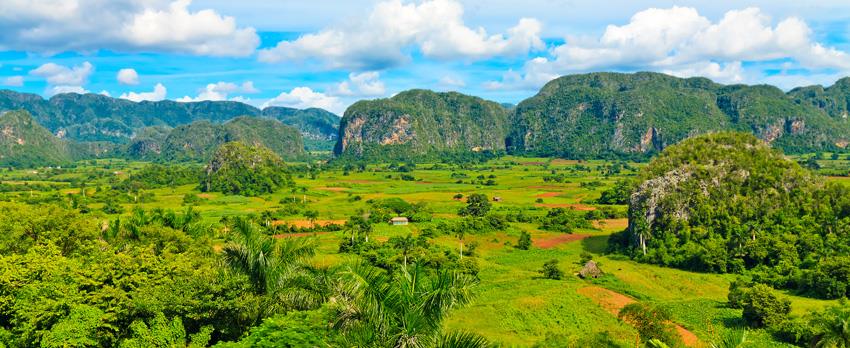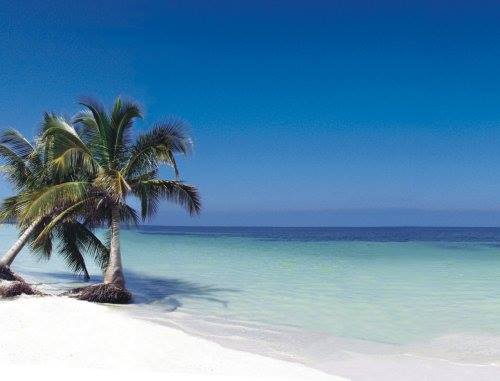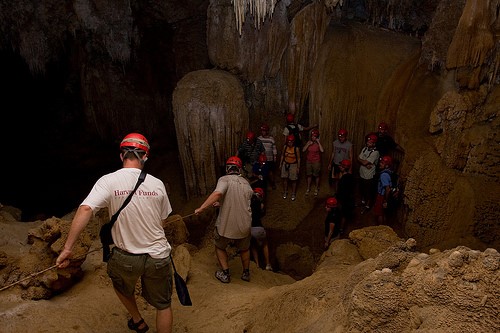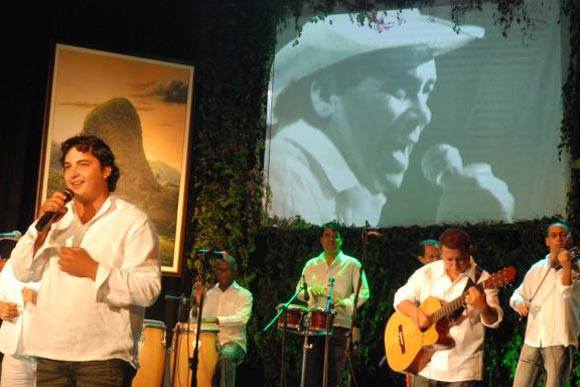1.Valle Vi??ales

An official national park and by far the most visited location in Pinar del R??o, the jewel in the province???s crown is the valley of vi??ales, with its fantastically located accommodation, striking landscapes and an atmosphere of complete serenity. Though only 25km north of Pinar del R??o city, the valley feels very remote, with a lost-world quality that???s mainly due to the unique mogotes, the boulder-like hills that look as if they???ve dropped from the sky onto the valley floor. These bizarre hillocks were formed by erosion during the Jurassic period, some 160 million years ago. Rainfall slowly ate away at the dissolvable limestone and flattened much of the landscape, leaving a few survivors behind, their lumpy surface today coated in a bushy layer of vegetation. Easily the most photographed examples are the Mogote Dos Hermanas or ???twin sisters???, two huge cliffy mounds hulking next to one another on the west side of the valley, with acres of flat fields laid out before them serving to emphasize the abruptness of these strange explosions of rock. For the archetypal view of the valley, head for the viewing platform at the Hotel Jazmines, a few hundred metres??? detour off the main road from Pinar del R??o, just before it slopes down to the valley floor.??Laidback locals and a sensitive approach to commercialization ensure that Vi??ales retains a sense of pre-tourism authenticity absent from other popular destinations. The tourist centres and hotels are kept in isolated pockets of the valley, often hidden away behind the mogotes, and driving through it???s sometimes easy to think that the locals are the only people around. Most of the population lives in the small village of Vi??ales, which you???ll enter first if you arrive from the provincial capital or Havana, and where there are plenty of casas particulares. It???s also one of the few places in the country that acts as a hub for independent travellers and is a good place to hook up with travel buddies. From the village it???s a short drive to all the official attractions, most of which are set up for tour groups, but it???s still worth doing the circuit just to get a feel of the valley and a close look at the mogotes. If time is limited, concentrate your visit on the San Vicente region, a valley within the valley and home to the Cueva del Indio, the most comprehensive accessible cave system in Vi??ales. Also in San Vicente are the Cueva de San Miguel and El Palenque de los Cimarrones, the latter a much smaller cave leading through the rock to a rustic encampment where runaway slaves once hid, but now set up to provide lunchtime entertainment for coach parties. Difficult-to-explore and little-visited Valle Anc??n lies on the northern border of this part of the valley. On the other side of the village, the Mural de la Prehistoria is by far the most contrived of the valley???s attractions.
The valley supports its own microclimate, and from roughly June to October it rains most afternoons, making it a good idea to get your sightseeing done in the mornings. Mosquitoes are also more prevalent at this time of year and insect repellent is a definite must for any visit.
2. Orquideario

Cuba is home to more than 300 species of orchids, some??native only to Cuba. The Soroa Orchidarium, a botanical garden dedicated to education and the cultivation and conservation of the world???s orchids.
The groves of Cuban royal palms (Roystonea regia) on either side of the Orchidarium are meant to evoke the hills of Sierra del Rosario, a biosphere reserve of over 65,000 acres within which the Orchidarium is nestled. The Orchidarium features thousands of tropical plants and flowers from around the world, including 700 species of orchids from Asia, South America, and other tropical regions, many no longer found in the wild.
Founded in 1943 by botanist Tom??s Felipe Camacho, the Orchidarium is maintained today by the University of P??nar del R??o. In addition to the living collections, Camacho assembled a library of books specializing in orchids and other ornamental plants still considered to be the richest and most varied and up-to-date in the country.
The Orchid Show Cuban-born designer Jorge S??nchez, of the landscape architecture firm S??nchez & Maddux, calls the Sierra del Rosario ???magical;??? the mountains are very old and very green, with tremendous amounts of rainfall that make everything grow extremely well, he relates on The Orchid Show Audio Tour.
3.Cayo Levisa

Located on the North seashore of Pinar del R??o, the westernmost province of Cuba, Cayo Levisa (Sting Ray Key) offers a secluded getaway for those looking for privacy and at the same time love the mysterious Silent World that extends beneath the warm and blue waters of the Caribbean.?? It takes about thirty minutes in safe yachts to reach this islet, blessed with 3 Km. of excellent beach and with 23 defined sites for SCUBA Diving. Only 3 miles away, you can visit cayo Paraiso (Paradise Key), named by no other that Ernest Hemingway himself, that made of this little key his personal hideaway through the decades of the 40s and 50s.
4.Cuevas de Santo Tom??s

Cuba???s largest cave system and the second-largest on the American continent. There are over 46km of galleries on eight levels, with a 1km section accessible to visitors. There???s no artificial lighting, but headlamps are provided for the 90-minute guided tour. Highlights include bats, stalagmites and stalactites, underground pools, interesting rock formations and a replica of an ancient native Indian mural.
5.Centro Cultural Polo Monta??ez

With the rhythm of the tres, the people of Vi??ales cheer up the nights of those visiting their homeland. The tres is an instrument that distinguishes the famous Cuban rhythm: the Son, which has become, for years, the main proposal of Polo Montanez Cultural Center, located in the world famous town of Vi??ales.
Fernando Borrego Linares, worldwide known as Polo Monta??ez, was a Cuban son singer and composer. He died on November 20th, 2002. Nowadays, this plaza pays homage to one of the musicians that most prestige has given to Cuban music.
6. F??brica de Tabaco Francisco Donatien

About a third of the people who live in the province of Pinar del R??o live in the city by the same name, and in the middle of that city is the Francisco Donati??n factory. The building is actually an antique prison that was transformed into a cigar factory in the 1960s. For decades the only cigars made here were for local consumption, but in the 1990s the fabrica began making a brand called Vegueros, which featured thin shapes and an atypical white and green cigar label.??You can still see the Vegueros image all over the Francisco Donati??n factory, but the brand has been discontinued. Today 90 percent of the cigars made here are Trinidads, a brand that was relocated here from Havana???s El Laguito.??(As with Vegueros, Trinidad is known for its lancero shape.) The factory, which also rolls some Romeo y Julietas, is one of the smallest in Cuba, with only 58 cigar rollers.
Francisco Donati??n is open to tourists (the entrance fee is $10) and is quite ready for visitors???perhaps a bit too ready. Unlike other cigar factories, where you can get up close and personal to the workers, tourists here are kept separate from the rolling gallery by a wooden rail, so you have to observe from a distance. Other parts of the cigarmaking process take place behind glass.??There???s a little retail area in the courtyard where you can buy a Cuban flag or a Che Guevara T-shirt, if you???re so inclined, and the factory has a decent cigar store. It even had a few old Vegueros cigars in May. Stocks were very good, although a few of the cigars were slightly beat up in appearance. If you???re shopping here, choose a Trinidad Fundadore, one of Cuba???s greatest thin cigars, which is made right on the premises, and puff away, but we prefer to buy across the street.
7. Mar??a La Gorda Diving Center

Maria La Gorda diving zone, in the Ensenada de Corrientes, is one of the most protected areas in Cuba with an amazing coral reef development, located at a very short distance from the coast. From 5 meters (16 feet) you can see big and insolated patches of coral with an abundant sessile fauna, specially gorgonians and sea fans, more than 20 species of coral and lots of small and medium size fish. Lobsters, morays and crabs can be frequently seen in the boles of the bottom.??From 10 meters (33 feet) deep these patches are joined together and increasingly higher, thus forming a chain of tall coral hillocks cut by channels and passages, with walls falling sharply and deeply. This wall shows attractive structures such as holes, tunnels and vertical caves, where you can see beautiful black coral colonies, big tubular branch or cup shape sponges and 2 meters (6.5 feet) high gorgonians.??Among the fish that move along the wall we can mention barracudas, jacks, dogsnappers, snappers and schoolmasters. You can also see eagle rays and stingrays.??Sometimes and with a little bit of luck some mantas and whale shark can be observed. This Diving Center has 50 sites of high level diving, some are still not named, all of them are less than 1 hour cruise, some at even 5 minutes away. Generally, they are all much alike, many are suitable for wall diving, but each one has its particular charm.
May 21, 2006
Top sights in Pinar del R??o 0
by Carlos Rodriguez • Location Spotlight, Travelers
1.Valle Vi??ales

An official national park and by far the most visited location in Pinar del R??o, the jewel in the province???s crown is the valley of vi??ales, with its fantastically located accommodation, striking landscapes and an atmosphere of complete serenity. Though only 25km north of Pinar del R??o city, the valley feels very remote, with a lost-world quality that???s mainly due to the unique mogotes, the boulder-like hills that look as if they???ve dropped from the sky onto the valley floor. These bizarre hillocks were formed by erosion during the Jurassic period, some 160 million years ago. Rainfall slowly ate away at the dissolvable limestone and flattened much of the landscape, leaving a few survivors behind, their lumpy surface today coated in a bushy layer of vegetation. Easily the most photographed examples are the Mogote Dos Hermanas or ???twin sisters???, two huge cliffy mounds hulking next to one another on the west side of the valley, with acres of flat fields laid out before them serving to emphasize the abruptness of these strange explosions of rock. For the archetypal view of the valley, head for the viewing platform at the Hotel Jazmines, a few hundred metres??? detour off the main road from Pinar del R??o, just before it slopes down to the valley floor.??Laidback locals and a sensitive approach to commercialization ensure that Vi??ales retains a sense of pre-tourism authenticity absent from other popular destinations. The tourist centres and hotels are kept in isolated pockets of the valley, often hidden away behind the mogotes, and driving through it???s sometimes easy to think that the locals are the only people around. Most of the population lives in the small village of Vi??ales, which you???ll enter first if you arrive from the provincial capital or Havana, and where there are plenty of casas particulares. It???s also one of the few places in the country that acts as a hub for independent travellers and is a good place to hook up with travel buddies. From the village it???s a short drive to all the official attractions, most of which are set up for tour groups, but it???s still worth doing the circuit just to get a feel of the valley and a close look at the mogotes. If time is limited, concentrate your visit on the San Vicente region, a valley within the valley and home to the Cueva del Indio, the most comprehensive accessible cave system in Vi??ales. Also in San Vicente are the Cueva de San Miguel and El Palenque de los Cimarrones, the latter a much smaller cave leading through the rock to a rustic encampment where runaway slaves once hid, but now set up to provide lunchtime entertainment for coach parties. Difficult-to-explore and little-visited Valle Anc??n lies on the northern border of this part of the valley. On the other side of the village, the Mural de la Prehistoria is by far the most contrived of the valley???s attractions.
The valley supports its own microclimate, and from roughly June to October it rains most afternoons, making it a good idea to get your sightseeing done in the mornings. Mosquitoes are also more prevalent at this time of year and insect repellent is a definite must for any visit.
2. Orquideario

Cuba is home to more than 300 species of orchids, some??native only to Cuba. The Soroa Orchidarium, a botanical garden dedicated to education and the cultivation and conservation of the world???s orchids.
The groves of Cuban royal palms (Roystonea regia) on either side of the Orchidarium are meant to evoke the hills of Sierra del Rosario, a biosphere reserve of over 65,000 acres within which the Orchidarium is nestled. The Orchidarium features thousands of tropical plants and flowers from around the world, including 700 species of orchids from Asia, South America, and other tropical regions, many no longer found in the wild.
Founded in 1943 by botanist Tom??s Felipe Camacho, the Orchidarium is maintained today by the University of P??nar del R??o. In addition to the living collections, Camacho assembled a library of books specializing in orchids and other ornamental plants still considered to be the richest and most varied and up-to-date in the country.
The Orchid Show Cuban-born designer Jorge S??nchez, of the landscape architecture firm S??nchez & Maddux, calls the Sierra del Rosario ???magical;??? the mountains are very old and very green, with tremendous amounts of rainfall that make everything grow extremely well, he relates on The Orchid Show Audio Tour.
3.Cayo Levisa

Located on the North seashore of Pinar del R??o, the westernmost province of Cuba, Cayo Levisa (Sting Ray Key) offers a secluded getaway for those looking for privacy and at the same time love the mysterious Silent World that extends beneath the warm and blue waters of the Caribbean.?? It takes about thirty minutes in safe yachts to reach this islet, blessed with 3 Km. of excellent beach and with 23 defined sites for SCUBA Diving. Only 3 miles away, you can visit cayo Paraiso (Paradise Key), named by no other that Ernest Hemingway himself, that made of this little key his personal hideaway through the decades of the 40s and 50s.
4.Cuevas de Santo Tom??s

Cuba???s largest cave system and the second-largest on the American continent. There are over 46km of galleries on eight levels, with a 1km section accessible to visitors. There???s no artificial lighting, but headlamps are provided for the 90-minute guided tour. Highlights include bats, stalagmites and stalactites, underground pools, interesting rock formations and a replica of an ancient native Indian mural.
5.Centro Cultural Polo Monta??ez

With the rhythm of the tres, the people of Vi??ales cheer up the nights of those visiting their homeland. The tres is an instrument that distinguishes the famous Cuban rhythm: the Son, which has become, for years, the main proposal of Polo Montanez Cultural Center, located in the world famous town of Vi??ales.
Fernando Borrego Linares, worldwide known as Polo Monta??ez, was a Cuban son singer and composer. He died on November 20th, 2002. Nowadays, this plaza pays homage to one of the musicians that most prestige has given to Cuban music.
6. F??brica de Tabaco Francisco Donatien

About a third of the people who live in the province of Pinar del R??o live in the city by the same name, and in the middle of that city is the Francisco Donati??n factory. The building is actually an antique prison that was transformed into a cigar factory in the 1960s. For decades the only cigars made here were for local consumption, but in the 1990s the fabrica began making a brand called Vegueros, which featured thin shapes and an atypical white and green cigar label.??You can still see the Vegueros image all over the Francisco Donati??n factory, but the brand has been discontinued. Today 90 percent of the cigars made here are Trinidads, a brand that was relocated here from Havana???s El Laguito.??(As with Vegueros, Trinidad is known for its lancero shape.) The factory, which also rolls some Romeo y Julietas, is one of the smallest in Cuba, with only 58 cigar rollers.
Francisco Donati??n is open to tourists (the entrance fee is $10) and is quite ready for visitors???perhaps a bit too ready. Unlike other cigar factories, where you can get up close and personal to the workers, tourists here are kept separate from the rolling gallery by a wooden rail, so you have to observe from a distance. Other parts of the cigarmaking process take place behind glass.??There???s a little retail area in the courtyard where you can buy a Cuban flag or a Che Guevara T-shirt, if you???re so inclined, and the factory has a decent cigar store. It even had a few old Vegueros cigars in May. Stocks were very good, although a few of the cigars were slightly beat up in appearance. If you???re shopping here, choose a Trinidad Fundadore, one of Cuba???s greatest thin cigars, which is made right on the premises, and puff away, but we prefer to buy across the street.
7. Mar??a La Gorda Diving Center

Maria La Gorda diving zone, in the Ensenada de Corrientes, is one of the most protected areas in Cuba with an amazing coral reef development, located at a very short distance from the coast. From 5 meters (16 feet) you can see big and insolated patches of coral with an abundant sessile fauna, specially gorgonians and sea fans, more than 20 species of coral and lots of small and medium size fish. Lobsters, morays and crabs can be frequently seen in the boles of the bottom.??From 10 meters (33 feet) deep these patches are joined together and increasingly higher, thus forming a chain of tall coral hillocks cut by channels and passages, with walls falling sharply and deeply. This wall shows attractive structures such as holes, tunnels and vertical caves, where you can see beautiful black coral colonies, big tubular branch or cup shape sponges and 2 meters (6.5 feet) high gorgonians.??Among the fish that move along the wall we can mention barracudas, jacks, dogsnappers, snappers and schoolmasters. You can also see eagle rays and stingrays.??Sometimes and with a little bit of luck some mantas and whale shark can be observed. This Diving Center has 50 sites of high level diving, some are still not named, all of them are less than 1 hour cruise, some at even 5 minutes away. Generally, they are all much alike, many are suitable for wall diving, but each one has its particular charm.